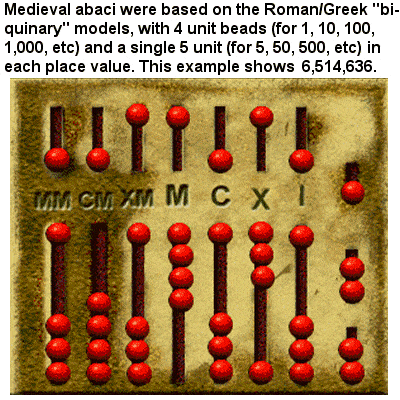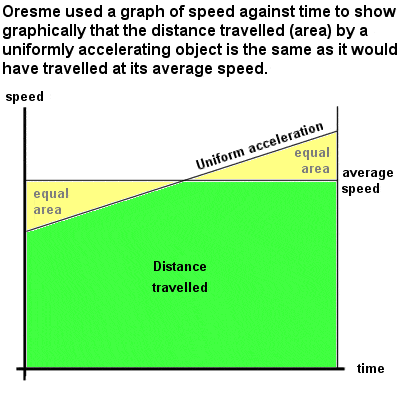MEDIEVAL MATHEMATICS
 |
Medieval abacus, based on the Roman/Greek model |
During the centuries in which the Chinese, Indian and Islamic mathematicians had been in the ascendancy, Europe had fallen into the Dark Ages, in which science, mathematics and almost all intellectual endeavour stagnated.
Scholastic scholars only valued studies in the humanities, such as philosophy and literature, and spent much of their energies quarrelling over subtle subjects in metaphysics and theology, such as “How many angels can stand on the point of a needle?“
From the 4th to 12th Centuries, European knowledge and study of arithmetic, geometry, astronomy and music was limited mainly to Boethius’ translations of some of the works of ancient Greek masters such as Nicomachus and Euclid. All trade and calculation was made using the clumsy and inefficient Roman numeral system, and with an abacus based on Greek and Roman models.
By the 12th Century, though, Europe, and particularly Italy, was beginning to trade with the East, and Eastern knowledge gradually began to spread to the West. Robert of Chester translated Al-Khwarizmi‘s important book on algebra into Latin in the 12th Century, and the complete text of Euclid‘s “Elements” was translated in various versions by Adelard of Bath, Herman of Carinthia and Gerard of Cremona. The great expansion of trade and commerce in general created a growing practical need for mathematics, and arithmetic entered much more into the lives of common people and was no longer limited to the academic realm.
The advent of the printing press in the mid-15th Century also had a huge impact. Numerous books on arithmetic were published for the purpose of teaching business people computational methods for their commercial needs and mathematics gradually began to acquire a more important position in education.
Europe’s first great medieval mathematician was the Italian Leonardo of Pisa, better known by his nickname Fibonacci. Although best known for the so-called Fibonacci Sequence of numbers, perhaps his most important contribution to European mathematics was his role in spreading the use of the Hindu-Arabic numeral system throughout Europe early in the 13th Century, which soon made the Roman numeral system obsolete, and opened the way for great advances in European mathematics.
 |
Oresme was one of the first to use graphical analysis |
An important (but largely unknown and underrated) mathematician and scholar of the 14th Century was the Frenchman Nicole Oresme. He used a system of rectangular coordinates centuries before his countryman René Descartes popularized the idea, as well as perhaps the first time-speed-distance graph. Also, leading from his research into musicology, he was the first to use fractional exponents, and also worked on infinite series, being the first to prove that the harmonic series 1⁄1 + 1⁄2 + 1⁄3 + 1⁄4 + 1⁄5… is a divergent infinite series (i.e. not tending to a limit, other than infinity).
The German scholar Regiomontatus was perhaps the most capable mathematician of the 15th Century, his main contribution to mathematics being in the area of trigonometry. He helped separate trigonometry from astronomy, and it was largely through his efforts that trigonometry came to be considered an independent branch of mathematics. His book “De Triangulis“, in which he described much of the basic trigonometric knowledge which is now taught in high school and college, was the first great book on trigonometry to appear in print.
Mention should also be made of Nicholas of Cusa (or Nicolaus Cusanus), a 15th Century German philosopher, mathematician and astronomer, whose prescient ideas on the infinite and the infinitesimal directly influenced later mathematicians like Gottfried Leibniz and Georg Cantor. He also held some distinctly non-standard intuitive ideas about the universe and the Earth’s position in it, and about the elliptical orbits of the planets and relative motion, which foreshadowed the later discoveries of Copernicus and Kepler.
<< Back to Al-Khwarizmi | Forward to Fibonacci >> |
